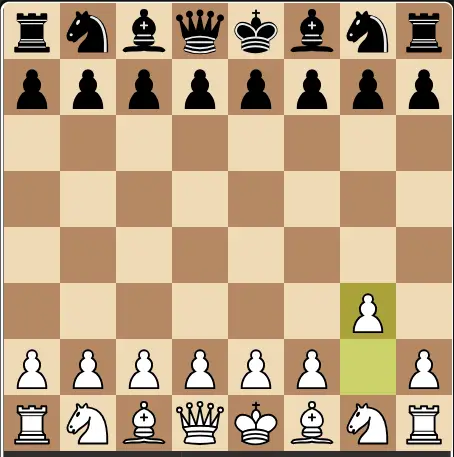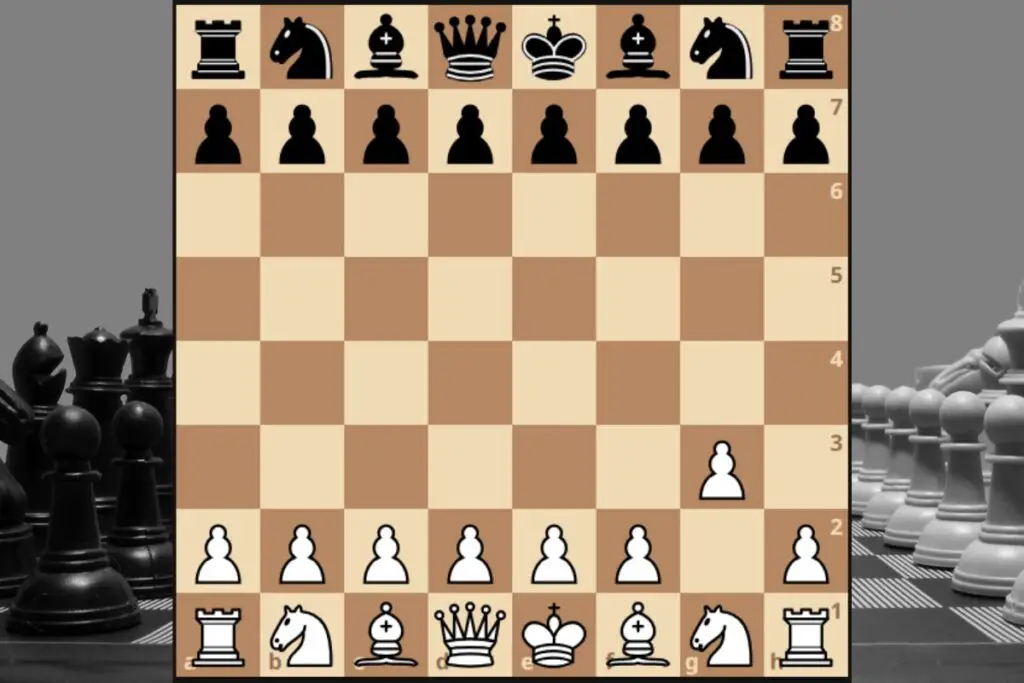In this article, we explore the enigmatic Hungarian Chess Opening—an uncommon yet captivating choice. Unravel the secrets of this unique opening, its variations, statistics and the strategic intricacies that make it a fascinating option for players seeking diversity.
What Is The Hungarian Opening?
The Hungarian Opening, also known as the Benko Opening and the King’s Fianchetto Opening, starts with the move 1. g3.
While it doesn’t directly influence the center, it sets the stage for fianchettoing the Bishop to g2, which accomplishes that goal.
This opening aligns with the hypermodern school of thought that emerged in the 1920s and 1930s, emphasizing controlling the center from a distance using pieces rather than pawns.
Starting Position Of Hungarian Opening

With its long-term prospects, the Hungarian Opening allows White to apply pressure on the center and Black’s Queenside.
One significant advantage is the ease with which White can castle Kingside, fortifying their position. In this opening, White commonly adopts the Barcza System, placing a Bishop on g2 and a Knight on f3.
Black, in turn, can mirror White’s fianchetto, leading to a hypermodern Fianchetto formation.
Overall, the Hungarian Opening ranks as the 5th most popular initial move, offering players diverse strategic opportunities on the chessboard.
Is the Hungarian Opening good for Beginners?
The Hungarian Opening (1. g3) can be a viable option for beginners, but it may not be the most straightforward or the most commonly recommended opening for players new to chess. Here are some considerations:
Simplicity
One of the main reasons why certain openings are often recommended for beginners is their simplicity. Openings like the Italian Game (1. e4 e5 2. Nf3 Nc6 3. Bc4) and the Queen’s Gambit (1. d4 d5 2. c4) have well-defined plans and straightforward pawn structures, making them easier to grasp for beginners.
Central Control
While the Hungarian Opening prepares to fianchetto the bishop to g2, it does not directly influence the center in the opening moves. Controlling the center is a fundamental principle in chess, and beginner-friendly openings usually prioritize this aspect.
Development
Beginner openings often focus on piece development, aiming to get the pieces out efficiently to set the stage for a strong middlegame. The Hungarian Opening’s pawn move may not contribute directly to this goal.
Flexibility
For beginners, it’s helpful to play openings that lead to a wide variety of positions. This exposure to different structures and plans can enhance their overall understanding of the game.
The Hungarian Opening is relatively flexible in this regard, as it can transpose to various setups.
Ultimately, the choice of opening for beginners should prioritize understanding basic principles, such as controlling the center, developing pieces, and ensuring a safe king position.
For this reason, classical and straightforward openings are often recommended, like the Italian Game, the Queen’s Gambit, or even the King’s Pawn Opening (1. e4).
As a beginner, it’s crucial to focus on overall chess fundamentals, such as tactics, positional understanding, and endgames, rather than getting bogged down with complex opening lines.
As you progress and gain more experience, you can explore and experiment with different openings, including the Hungarian Opening, to expand your repertoire and style of play.
Statistics
Approximate chances:
White win 38%, Draw 36%, Black win 28%
Estimated next move popularity:
Variations: d5 34%, e5 17%, Nf6 16%, g6 15%, c5 9%, e6 3%, f5 2%, c6 2%, d6 1%
g3 Opening Counter
The g3 opening, also known as the King’s Fianchetto Opening, is a flexible and solid choice for White. To counter the g3 opening effectively as Black, you can adopt various approaches. Here are some common strategies:
Control the Center: As in most openings, focus on controlling the central squares (d4, d5, e4, e5). Aim to establish a strong pawn presence in the center to limit White’s options and support your piece development.
Develop Your Pieces: Develop your pieces actively and harmoniously. Knights should typically be developed to f6 and c6, and bishops to e7 and/or g7. This setup allows for solid development while maintaining flexibility.
Pawn Breaks: Look for opportunities to break open the center with pawn breaks like …d5 or …c5. These moves can challenge White’s control and open lines for your pieces.
Target Weaknesses: Observe any weaknesses in White’s position due to the fianchetto structure. Focus on exploiting these weak points through targeted attacks.
Watch for Tactics: Be vigilant for tactical opportunities. The g3 pawn move can lead to tactical vulnerabilities, especially on the light squares near White’s king. Look for tactics involving pins, forks, or discoveries.
Queenside Expansion: Consider expanding on the queenside with moves like …b5 and …a5. This can create counterplay and prevent White from expanding comfortably on that side of the board.
Minor Piece Exchanges: If White develops their knight to f3 and fianchettos the king’s bishop, exchanging your light-squared bishop for their light squared bishop can help weaken the light squares around White’s king.
Castle Safely: Ensure the safety of your king by castling early. Kingside castling (O-O) is often a solid choice, as it puts your king behind a wall of pawns.
Flexible Play: The g3 opening is versatile, and White’s setup can change depending on Black’s responses. Be flexible in your approach, and avoid committing too early to a fixed plan.
Understanding the g3 opening’s characteristics and common ideas will help you formulate a strong counterplay as Black. Stay flexible, maintain good development, and seize any tactical opportunities that arise to keep White’s position under pressure. Practice and study games featuring the g3 opening to further refine your counter-strategies.
Final Thoughts
In conclusion, the Hungarian Chess Opening unveils a captivating realm of possibilities on the chessboard. Its unconventional nature and strategic subtleties make it a compelling choice for players looking to surprise their opponents and explore uncharted territories.
By delving into the history, variations, and tactical nuances of this opening, one can enhance their chess repertoire and elevate their game to new heights.
Whether you embrace it as White or challenge it as Black, the Hungarian Opening promises an exciting and enriching journey in the ever-evolving world of chess. So, dare to venture into the realm of the Hungarian Opening, where creativity meets tradition, and mastery awaits the intrepid chess player.


